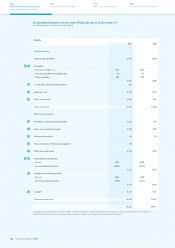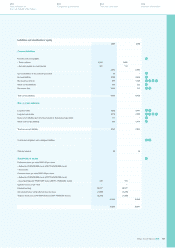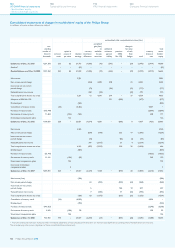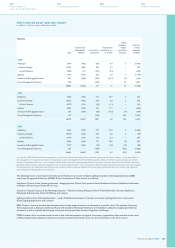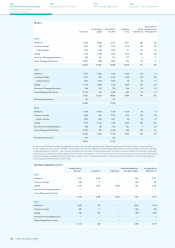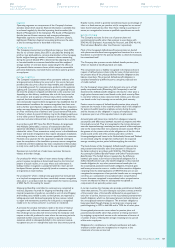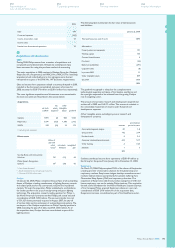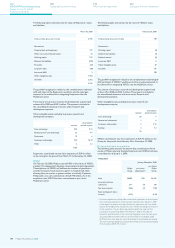Philips 2008 Annual Report Download - page 137
Download and view the complete annual report
Please find page 137 of the 2008 Philips annual report below. You can navigate through the pages in the report by either clicking on the pages listed below, or by using the keyword search tool below to find specific information within the annual report.
Segments
Operating segments are components of the Company’s business
activities about which separate financial information is available that
is evaluated regularly by the chief operating decision-maker (the
Board of Management of the Company). The Board of Management
decides how to allocate resources and assesses performance.
Reportable segments comprise: Healthcare, Consumer Lifestyle,
Lighting, and Television. Segment accounting policies are the same
as the accounting policies as described in this note.
Earnings per share
The Company presents basic and diluted earnings per share (EPS)
data for its common shares. Basic EPS is calculated by dividing the
profit or loss attributable to common shareholders of the Company
by the weighted average number of common shares outstanding
during the period. Diluted EPS is determined by adjusting the profit
or loss attributable to common shareholders and the weighted
average number of common shares outstanding for the effects of
all potential dilutive common shares, which comprise convertible
personnel debentures, restricted shares and share options granted
to employees.
Revenue recognition
The Company recognizes revenue when persuasive evidence of an
arrangement exists, delivery has occurred or the service has been
provided, the sales price is fixed or determinable, and collectibility
is reasonably assured. For consumer-type products in the segments
Lighting and Consumer Lifestyle, these criteria are generally met at
the time the product is shipped and delivered to the customer and,
depending on the delivery conditions, title and risk have passed to
the customer and acceptance of the product, when contractually
required, has been obtained, or, in cases where such acceptance is
not contractually required, when management has established that all
aforementioned conditions for revenue recognition have been met
and no further post-shipment obligations exist other than obligations
under warranty. Examples of the above-mentioned delivery conditions
are ‘Free on Board point of delivery’ and ‘Costs, Insurance Paid point
of delivery’, where the point of delivery may be the shipping warehouse
or any other point of destination as agreed in the contract with the
customer and where title and risk in the goods pass to the customer.
In accordance with EITF Issue No. 00-21, ‘Revenue Arrangements
with Multiple Deliverables’, revenues of transactions that have
separately identifiable components are recognized based on their
relative fair values. These transactions mainly occur in the Healthcare
Sector and include arrangements that require subsequent installation
and training activities in order to become operable for the customer.
However, since payment for the equipment is typically contingent
upon the completion of the installation process, revenue recognition
is deferred until the installation has been completed and the product
is ready to be used by the customer in the way contractually agreed.
Revenues are recorded net of sales taxes, customer discounts,
rebates and similar charges.
For products for which a right of return exists during a defined
period, revenue recognition is determined based on the historical
pattern of actual returns, or in cases where such information is
lacking, revenue recognition is postponed until the return period
has lapsed. Return policies are typically based on customary return
arrangements in local markets.
For products for which a residual value guarantee has been granted
or a buy-back arrangement has been concluded, revenue recognition
takes place in accordance with the requirements for lease accounting
of SFAS No.13, ‘Accounting for Leases’.
Shipping and handling costs billed to customers are recognized as
revenues. Expenses incurred for shipping and handling costs of
internal movements of goods are recorded as cost of sales. Shipping
and handling costs related to sales to third parties are reported as
selling expenses and disclosed separately. Service revenue related
to repair and maintenance activities for sold goods is recognized
ratably over the service period or as services are rendered.
A provision for product warranty is made at the time of revenue
recognition and reflects the estimated costs of replacement and
free-of-charge services that will be incurred by the Company with
respect to the sold products. In cases where the warranty period is
extended and the customer has the option to purchase such an
extension, which is subsequently billed to the customer, revenue
recognition occurs on a straight-line basis over the contract period.
Royalty income, which is generally earned based upon a percentage of
sales or a fixed amount per product sold, is recognized on an accrual
basis. Government grants, other than those relating to purchases of
assets, are recognized as income as qualified expenditures are made.
Benefit accounting
The Company accounts for the cost of pension plans and
postretirement benefits other than pensions in accordance with
SFAS No. 87, ‘Employers’ Accounting for Pensions’, and SFAS No. 106,
‘Postretirement Benefits other than Pensions’, respectively.
Most of the Company’s defined-benefit pension plans are funded
with plan assets that have been segregated and restricted in a trust or
foundation to provide for the pension benefits to which the Company
has committed itself.
The Company also sponsors certain defined-benefit pension plans,
which are funded as benefit payments are made.
The net pension asset or liability recognized in the balance sheet in
respect of defined pension plans is the fair value of plan assets less
the present value of the projected defined-benefit obligation at the
balance sheet date. The projected defined-benefit obligation is
calculated annually by qualified actuaries using the projected unit
of credit method.
For the Company’s major plans, a full discount rate curve of high
quality corporate bonds (Bloomberg AA Composite) is used to
determine the defined-benefit obligation whereas for other plans a
single point discount rate is used based on the plan’s maturity. Plans
in countries without a deep corporate bond market, use a discount
rate based on the local sovereign curve and the plan’s maturity.
Pension costs in respect of defined-benefit pension plans primarily
represent the increase in the actuarial present value of the obligation
for pension benefits based on employee service during the year
and the interest on this obligation in respect of employee service
in previous years, net of the expected return on plan assets.
Actuarial gains and losses arise mainly from changes in actuarial
assumptions and differences between actuarial assumptions and what
has actually occurred. They are recognized in the income statement,
over the expected average remaining service periods of the employees,
only to the extent that their net cumulative amount exceeds 10% of
the greater of the present value of the obligation or of the fair value
of plan assets at the end of the previous year (the corridor).
Unrecognized gains and losses in the Netherlands, France and Thailand
are amortized using the straight-line method over the expected
average remaining service period without applying the corridor.
The funded status of the Company’s defined-benefit pension plans
and postretirement benefits other than pensions is reflected on
the balance sheet in accordance with SFAS No. 158, ‘Employers
Accounting for Defined Benefit Pension and Other Postretirement
Benefit plans’. The funded status is measured as the difference
between plan assets at fair value and the benefit obligation. For a
defined-benefit pension plan, the benefit obligation is the projected
benefit obligation; for any other postretirement benefit plan it is
the accumulated postretirement benefit obligation. Actuarial gains
and losses, prior-service costs or credits and the transition obligation
remaining from the initial application of SFAS 106 that are not yet
recognized as components of net periodic benefit cost are recognized,
net of tax, as a component of accumulated other comprehensive
income. Amounts recognized in accumulated other comprehensive
income are adjusted as they are subsequently recognized as
components of net periodic pension cost.
In certain countries, the Company also provides postretirement benefits
other than pensions. The cost relating to such plans consists primarily
of the present value of the benefits attributed on an equal basis to
each year of service, interest cost on the accumulated postretirement
benefit obligation, which is a discounted amount, and amortization of
the unrecognized transition obligation. This transition obligation is
being amortized through charges to earnings over a twenty-year
period beginning in 1993 in the USA and in 1995 for all other plans.
Unrecognized prior-service costs related to pension plans and
postretirement benefits other than pensions are being amortized
by assigning a proportional amount to the statements of income of
a number of years, reflecting the average remaining service period
of the active employees.
Obligations for contributions to defined-contribution and multi-
employer pension plans are recognized as an expense in the
statements of income as incurred.
Philips Annual Report 2008 137
254
Corporate governance
250
Reconciliation of
non-US GAAP information
262
Ten-year overview
266
Investor information



